BY KIKI TIDWELL

Our Silver River Place apartment building in Hailey is going right up and I have been working on a microgrid design for this all-electric building with solar and battery storage. This is breaking trail a bit in Idaho as there are almost no microgrids installed yet in this state, even though they have been widely deployed everywhere else. In fact, California’s utility, PGE [Pacific Gas and Electric Company], solicited bids this past December to install 20 microgrids next to its substations by June in advance of wildfire season. “In a presentation before the California Public Utilities Commission last week, PG&E said that the microgrids are expected to keep power flowing to thousands if not tens of thousands of customers per substation during a power shutoff.”[1] Microgrid technology is hitting its stride. “Navigant expects global microgrid capacity to reach 19,888.8 MW by 2028, up from 3,480.5 MW in 2019.”[2]
At the heart of a microgrid, and what makes it different than just a backup generator, is a controller, a ‘smart’ hardware and software component that can tell the system to ‘island’ the microgrid from the main grid in certain circumstances and run off of local power generation, whether it be solar panels or natural gas or diesel generators. For our building—and this may not be applicable to other situations—I would like to use the maximum amount of generation from our solar panels to be used by our building’s units first to reduce the amount of power that tenants will have to buy from Idaho Power. I see the solar component as an amenity of the building, like extra insulation or high-efficiency appliances that lower electrical bills; we won’t be charging tenants for this power. So, conceptually, the solar creates power all day that is delivered to the units and charges up a battery with any extra power generated. As the building goes into the evening hours, that stored battery energy is used until the battery gets low and the controller ‘smartly’ sees this signal and tells the system to stop islanding and connect back to the main grid for power.
If our building can provide much of its own power in the heat of July, it can help Idaho Power by reducing its demand from the main grid during peak irrigating summer days when the main grid system is straining at maximum load. Producing power right next to where it is going to be used is also very beneficial. “Delivering power from afar is inefficient because some of the electricity—as much as 8 to 15 percent—dissipates in transit.”[3] Idaho Power doesn’t have to produce 15 percent more power to get it to us at the edge of the grid here in Blaine County and all ratepayers don’t have to pay to build $300 million peaker plants for just that peak load capacity a couple of days a year.
We are lucky to have a great company, Schweitzer Engineering Laboratories, co-located in Idaho, with expertise in designing and installing microgrids worldwide. I was excited to talk to them recently about their microgrid controller options, their SEL-3530/3530-4 RTACs, which only cost $3000-$7000 as components (plus some engineering cost and software ‘library’). Right now the solar panels component is costing out at approximately $35,000 after federal tax credits and accelerated depreciation for a system that should provide 35,758 kWhs per year. Adding a solar generation microgrid is actually a reasonable part of the building’s overall cost, especially when it will result in much lower utility costs for tenants over the next 20 years. I would like to encourage other building developers to consider looking at a microgrid for their buildings and am happy to share our information further.
For anyone else curious for more information about microgrids and how they are being deployed rapidly all over, please go to https://microgridknowledge.com. The videoed sessions from their last conference are available now on their website for free, which is truly a bargain.
[1] https://microgridknowledge.com/pge-20-microgrids-wildfire/
[2] https://microgridknowledge.com/microgrid-defined/
[3] Ibid

